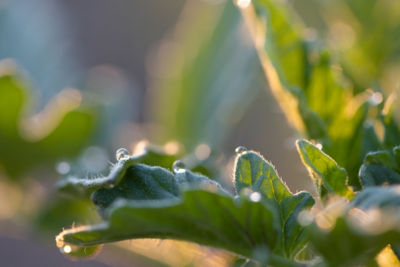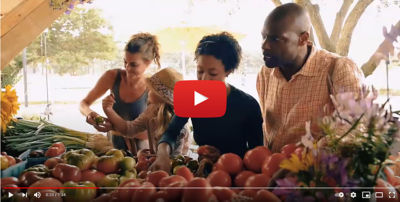Click here to download a PDF version of this spotlight.
» Hollow heart of watermelon is caused by inadequate pollination of female flowers.
» Watermelon varieties with dense fruit flesh are less susceptible to hollow heart.
» Hollow heart is more common on fruit that is set early in the season.
 Figure 1. Hollow heart symptoms in watermelon fruit.
Figure 1. Hollow heart symptoms in watermelon fruit.
Hollow heart is a condition of watermelon where cracks and hollow spaces develop inside the fruit (Figure 1) resulting from the separation of internal tissues.1,2 Externally, fruit severely affected by hollow heart can be triangular in shape (Figure 2). Hollow heart affects watermelon production throughout the U. S., and the condition lowers the marketability of the fruit resulting in millions of dollars of losses each year.2,3,4 It is difficult to determine which fruit are affected, and hollow heart is usually not detected until the fruit is cut open.5
 Figure 2. Triangular shaped fruit are indicative of hollow heart. Gerald Holmes, California Polytechnic State University at San Luis Obispo, Bugwood.org.
Figure 2. Triangular shaped fruit are indicative of hollow heart. Gerald Holmes, California Polytechnic State University at San Luis Obispo, Bugwood.org.
The USDA Agricultural Marketing Service (AMS) classifies hollow heart as a form of damage and has set standards for the amount of “damage” and “serious damage”, including hollow heart, that can be present in loads of watermelon (Table 1).6 To be classified in the grades U.S. Fancy and U.S. No. 1, watermelon fruit are to be “free from damage by any means.” To be classified in the grade U.S. No. 2, fruit are to be “free from serious damage by any means.” Tolerance levels are set for the percentage of fruit in a load that do not meet the standards for the grade (Table 2). A reduction of grade lowers the market value of the load.
Seedless watermelon varieties are known to be more susceptible to hollow heart than are seeded varieties.7 With 95% of U.S. watermelon production being seedless varieties, the economic impact of the problem can be substantial.1,2

CAUSE OF HOLLOW HEART
In the past, it was thought that varying soil moisture and excess nitrogen levels were the causes of hollow heart. However, research at the University of Delaware has shown that the primary cause of hollow heart is inadequate pollination.1 This explains why hollow heart occurs more frequently on triploid (seedless) varieties. Fruit set on triploid watermelons requires pollination with viable pollen. The pollen grains germinate and grow down the pollen tube on the female flower. During this fertilizationlike process, plant hormones are released and stimulate fruit cell division leading to fruit set and enlargement.1,8 Triploid watermelon plants produce male flowers but not viable pollen. The female flowers on triploid watermelon plants need to receive viable pollen from diploid (seeded) watermelon plants.
Therefore, diploid pollenizer varieties are planted along with triploid plants, usually in a 1:3 (diploid:triploid) ratio.5 The research at the University of Delaware found that there was no hollow heart in a hollow heart susceptible triploid variety when adequate pollenizer ratios and spacing were used. However, when the distance from triploid plants to pollenizer plants increased, the incidence of hollow heart increased. Triploid plants located five feet away from a pollenizer plant showed a hollow heart incidence of 56%, and plants located eight feet away from a pollenizer had a 74% incidence. A follow-up study found that decreasing the ratio of pollenizer plants in a planting of triploid watermelons was associated with an increase in the incidence of hollow heart.1,7
POLLINATION PROBLEMS
Inadequate pollination can result from (1) not enough pollen produced on the pollenizer plants, (2) inadequate rates of pollen transfer to female flowers, or (3) low pollen viability.5 Of these, the most common and easiest to prevent is inadequate pollen transfer. Female watermelon flowers require several visits from pollen carrying bees to allow for optimum fruit set. Flowers on triploid plants require a greater number of bee visits than do female flowers on diploid plants because the triploid male flowers do not produce viable pollen. Therefore, honey bees coming from the triploid male flowers do not contribute to the fertilization process. Each female flower on a triploid plant requires a minimum of 16 to 24 honey bee visits to result in optimum fruit set with a 1:3 pollenizer to triploid planting ratio, whereas female flowers on seeded varieties only require 6 honey bee visits for optimum fruit set.8
OTHER FACTORS
The incidence of hollow heart tends to be higher on early set fruit (fruit closest to the crown). Cooler temperatures and a higher frequency of storms early in the season suppress the activity of pollinators (honey bees).3,5,7 Cold weather is also associated with reduced pollen viability and reduced rates of pollination.5 Hollow heart is less likely to occur on fruit set later in the season.4 Prolonged periods of hot day-time temperatures also lower bee activity and pollination rates.
There is also variation of susceptibility to hollow heart among triploid varieties. Varieties with denser, firmer flesh show lower levels of hollow heart than varieties with less firm flesh. Watermelon fruit have uneven tissue expansion rates between the rind and heart tissues. During fruit expansion, the cells that make up the rind continue to divide, but heart tissue cells stop dividing seven to ten days after fruit set. The heart cells then increase in size but do not in number. If the cell expansion of the heart tissue cannot keep pace with the rind tissue growth, the tissues separate, and hollow heart develops.2,10
The process of fruit expansion is affected by the rate of pollination and the characteristics of the watermelon variety. Varieties with longer fruit (a length:width ratio greater than 1.26:1) are more likely to develop hollow heart.1,2 Yellow and orange flesh varieties also tend to have higher levels of hollow heart than do red-flesh varieties.3 There may be some association of hollow heart with soil moisture and nutrient levels, as these factors play a role in fruit expansion rates.
MANAGEMENT
Growers can choose less susceptible varieties with higher density flesh to minimize problems with hollow heart. Growers can also take steps to improve pollination rates including using the appropriate pollenizer to triploid ratio. It is important to use a pollenizer variety that begins producing pollen before the female flowers on the triploid plants are ready to be fertilized. Using a mix of pollenizers with different peak flowering times or a pollenizer with extended flowering can help ensure that pollen is available during the entire pollination period.3,10
Growers should supply the appropriate number of honey bee hives for the size of the watermelon planting, and place the hives in several locations around the field. Consider using bumblebees for pollination during periods of cold weather. Bumblebees are more efficient pollinators than are honey bees, and bumblebees are more active during periods of cold weather and low light intensity (cloudy days).1,3 Pesticide applications need to be managed to protect pollinating insects. Select planting dates to avoid cooler weather during the pollination period. Also, maintain vine vigor to promote good flower formation and fruit set.
SOURCES
1 Johnson, G. 2014. Watermelon pollination, fruit set, and hollow heart. Weekly crop update. University of Delaware. https://sites.udel.edu/weeklycropupdate/?p=6579.
2 Trandel, M., Perkins-Veazie, P., Schultheis, J., Gunter, C., Johanningsmeier, S., and Johannes, E. 2019. Presentation at the ASHS Annual Conference.
3 Guan, W. 2018. Hollowheart of watermelons. PPDL Picture of the Week. September 4, 2018. Purdue Agriculture, Plant and Pest Diagnostic Laboratory. https://ag.purdue.edu/btny/ppdl/Pages/POTW2018/POTW09042018.aspx.
4 Thomas, A. 2015. Researcher finds potential cause of hollow heart disorder in watermelons. Phys.Org. June 19, 2015. https://phys.org/news/2015-06-potential-hollow-heart-disorderwatermelons.html.
5 Thomas, A. 2015. Saving watermelons. UD Daily. University of Delaware.
http://www1.udel.edu/udaily/2015/jun/watermelons-061815.html. 6 United States Standards of Grades of Watermelon. USDA-AMS. Effective March 23, 2006. https://www.ams.usda.gov/grades-standards/watermelon-grades-and-standards.
7 Johnson, G. and Ernest, E. 2011. Conditions influencing hollow heart disorder in triploid watermelon. ASHS Annual Conference. https://www.researchgate.net/publication/267277292_Conditions_Influencing_Hollow_Heart_Disorder_In_Triploid_Watermelon.
8 Walters, A. 2005. Honey bee pollination requirements for triploid watermelon. HortScience 40:1268-1270.
9 Kano, Y. 1993. Relationship between the occurrence of hollowing in watermelon and the size and the number of fruit cells and intercellular air spaces. Journal of the Japanese Society for Horticultural Science 62:103-112.
10 Freeman, J., Miller, G., Olson, S. and Stall, W. 2007. Diploid with watermelon pollenizer cultivars differ respect to triploid watermelon yield. HortTechnology 17:518-522.
Websites verified 10/04/2019
ADDITIONAL INFORMATION
For additional agronomic information, please contact your local seed
representative.
Performance may vary from location to location and from year to year, as local growing, soil and weather conditions may vary. Growers should evaluate data from multiple locations and years whenever possible and should consider the impacts of these conditions on the grower’s fields. The recommendations in this article are based upon information obtained from the cited sources and should be used as a quick reference for information about watermelon production. The content of this article should not be substituted for the professional opinion of a producer, grower, agronomist, pathologist and similar professional dealing with this specific crop.
BAYER GROUP DOES NOT WARRANT THE ACCURACY OF ANY INFORMATION OR TECHNICAL ADVICE PROVIDED HEREIN AND DISCLAIMS ALL LIABILITY FOR ANY CLAIM INVOLVING SUCH INFORMATION OR ADVICE. 5070_S1 Published 11-06-2019
Bayer, Bayer Cross Design, and Seminis® are registered trademarks of Bayer Group. All other trademarks are property of their respective owners. © 2019 Bayer Group. All rights reserved.



